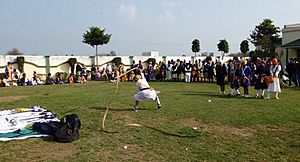Gatka facts for kids
Gatka is a special type of martial art that comes from South Asia, especially the Punjab region. While it's mostly known for being practiced by Sikh people today, other groups in India and Pakistan have also practiced it for a long time.
The word gatka actually refers to the wooden sticks used for practice. But now, many other weapons are also used. Gatka can be practiced as a sport (called khel) or as a traditional show or ceremony (called rasmi).
History of Gatka
Sikh people have a long history of martial arts. These traditions come from older fighting styles in India, especially from groups known for their bravery and fighting skills.
Guru Hargobind, an important Sikh leader, taught that his followers should be "warrior saints." This meant they should be ready to fight to protect themselves. Later, Guru Gobind Singh, the tenth Sikh Guru, also trained in martial arts in the Punjab. He created the Khalsa, a special group that helped Sikh people become strong fighters. He famously said he would "teach the sparrow to fight the hawk," meaning he would empower everyone, even the seemingly weak, to stand up to powerful enemies.
After the British took control of Punjab in the mid-1800s, they tried to stop Sikh people from practicing their martial arts. They even banned many tools and farming equipment. However, during a big rebellion in India in 1857, the Sikhs helped the British. Because of this, the rules about fighting practices became less strict.
The martial arts that came back after 1857 were different. Instead of training soldiers for war, the old fighting styles changed into gatka in the 1860s. This new style focused on using a sword training stick, which is where the name "gatka" comes from. It was mainly practiced by the British Indian Army. As Sikh colleges opened in the 1880s, European fencing rules were added to Gatka. This led to the two main types of Gatka we know today: rasmi (the ceremonial style) and khel (the sport style).
Weapons Used in Gatka
Using weapons correctly is a big part of Gatka. The techniques change depending on the weapon. The sword is a main weapon in Gatka and is often used with a shield. People also use throwing weapons like the Chakram, along with daggers and spears.
Here are some weapons used in Gatka:
- Talwar: A curved sword.
- Kirpan: A sharp dagger that baptized Sikhs always wear.
- Lathi: A stick made of bamboo, usually one to three meters long.
- Flexible weapons: Like whips and chains.
- Churi: A knife.
- Bow and arrow: Traditional Indian bows made of steel or composite bows made of wood, horn, and animal parts. The arrows usually have steel tips.
- Barcha: A spear.
- Khanda: A traditional straight sword used by Sikhs and Rajputs.
- Peshkarj: Another type of dagger.
- Kukri: A bent sword that gets wider towards its tip.
- Chakram: A circular weapon with sharp edges that can be thrown. Smaller ones can be worn like bracelets and used for punching.
- Bagh nakh: A weapon worn on the hand, shaped like a leopard's claw with spikes. It's similar to the Japanese shuko.
- Katara: A dagger that can pierce armor.
And many more!
Gatka Training
Because Gatka is closely connected to the Sikh faith, groups often train in religious places like a gurdwara (Sikh temple). There are also special training centers, called Akharas, just for teaching Gatka.
Gatka training often involves holding something in both hands. This could be two sticks, a stick and a sword, or a sword and a shield. Training with "both hands full" helps you coordinate both sides of your body. This idea is also found in many Filipino martial arts. Each person develops their own fighting style based on their favorite weapons and movements.
The basic idea of Gatka is to move your feet, body, arms, and weapons all together in a smooth way. Gatka focuses on rhythmic movement, without stopping or doubting yourself. The ways you attack and defend depend on how you position your hands, feet, and weapon(s) during practice.
Sometimes, holy verses are chanted during these exercises. A drummer often plays a three-beat rhythm, which helps with coordination during practice.
Images for kids
See also
 In Spanish: Gatka para niños
In Spanish: Gatka para niños







